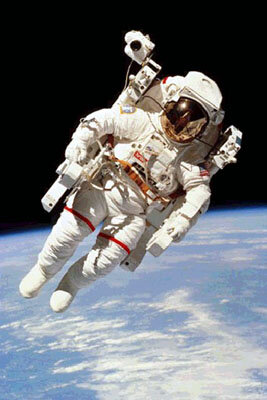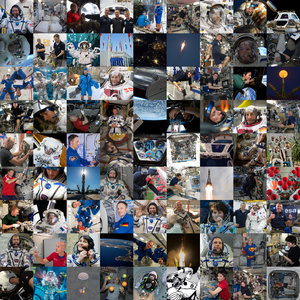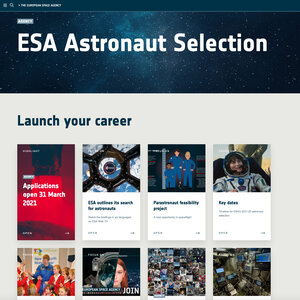Frequently Asked Questions
Q. How are environmental issues, such as the treatment of water and waste management, taken up on a spaceship or on the ISS?
A. The majority of ISS waste will be disposed of by means of destructive re-entry in the atmosphere. After having completed their resupply mission to the Station, Russian Progress vehicles and Japanese HTVs (and in the future European ATVs -Automated Transfer Vehicles) will be loaded with ISS waste and perform destructive re-entry into the atmosphere. Waste will in this fashion be burned with the vehicle itself. Toxic waste will be brought safely back to Earth by the Shuttle, and disposed of on the ground. Finally, a small portion of waste will be recycled, in particular water from condensation - which will be reused as drinkable water - and waste liquids that will be recycled as washing water.
Of particular interest is that all ISS Partners, ESA in particular, are focussing on improving recycling technologies. An example of this is project Melissa - a multinational programme between Europe and Canada - which aims at recycling human and other waste using bacteria in a closed loop, eco-friendly system. This technology is of paramount importance for future interplanetary missions, and, when applied to ground processes, for the life of all of us 'earthlings'.
For more information about Melissa, see: http://www.esa.int/export/esaCP/ESA9CV0VMOC_Life_0.html
Q. How do you become an astronaut? Can I get an application form? Is ESA recruiting now and will it in the future? What are the basic ESA requirements to become an astronaut?
A. Belgian astronaut Frank de Winne responds: "In this phase of assembly of the ISS the people that have been recruited to be astronauts are those used to risk and challenge, mostly pilots; however, in the future, during the years of the ISS utilisation, there will be a need for scientists and researchers"
French astronaut Philippe Perrin responds: "Even though scientific type of studies - from cellular biology to mathematics - are the most suited for becoming an astronaut, any kind of study can bring you to space as long as the curricula are complemented with courses related to space".
Please refer to HSF/Astronauts/How to become an astronaut.
Q. Do you need to be fit and healthy to go into space?
A.German astronaut Gerhard Thiele responds: "You don't need to be an athlete, and you can even have some minor physical defects, for instance a non-perfect sight. However, you need to be in good health, because in space your body is going to loose some of its muscular tone, and there is going to be bone decalcification. It's better to have reserves".
Q. Is there a danger from debris when in space?
A.French astronaut Philippe Perrin responds: "Inside the Space Station you are protected against debris of 1 cm of diameter, and the on-board radars will detect debris larger than 10 cm. In between, there is some risk we have to cope with".
Q. How do families cope when one of the members is an astronaut?
A.Italian astronaut Roberto Vittori responds: "The most difficult moment for the family is not the flight itself; this is what the public sees, but before the flight comes dozens of months of preparation, during which astronauts travel across the world to get trained and ready for flight. This is very difficult for the families to deal with".

Q. Where does the desire to become an astronaut come from?
A.Dutch astronaut André Kuipers responds: "This is a question I often ask myself. It's simply because beyond adventure, I have the desire to belong to the future of the human race. It's like the people who were travelling across unknown oceans centuries ago: they were discovering for the whole of humanity".
Q. Do people in space become taller?
A.French astronaut Leopold Eyharts responds: "In fact, in space the spine extends, and you can 'grow' up to 4 cm!"
Q. How do you go to the toilet and how do you sleep in space?
A. Due to the absence of gravity in space, an air suction system has been designed to collect urine and faeces; for men there is an additional tube. On the US Space Shuttle there is a camera for the astronaut to monitor if he/she is well positioned. When it comes to sleeping, for safety reasons astronauts strap themselves on to a wall in a sleeping bag to restrict their head, arms and legs; if not they would drift away with the air flow and could get hurt. The position of the body while sleeping is similar to that one of an unborn baby: neck loward towards the chest, arms bent with hands in front of the face, legs semi-retracted.
Q. How do I get an experiment to fly on-board the ISS?
A. Please refer to HSF/Research in space/User Information
Q. Can a student fly an experiment on-board the ISS?
A. Please refer to HSF/Education/The ISS Education programme
Q. What does the ISS cost?
A. The bad news is that the ISS, including its development, assembly and its running costs over at least ten years, comes to 100 billion euros. The good news is that the 100 billion figure is shared over a period of almost 30 years and between all the participants: the US, Russia, Canada, Japan and 10 of the 15 European nations who are part of ESA. The European share, at around 8 billion euros spread over the whole programme, amounts to just one euro spent by every european every year: less than the price of a cup of coffee in most of our big cities.
For further information please refer to HSF/ISS/European Participation/How much does it cost?
Q. What are the main benefits of the ISS?
A. The benefits derived from the research and technology development carried on board the ISS can be summarised as: scientific research in a physical environment not possible on Earth (weightlessness); observation and study of the Earth and the Universe from a vantage position outside the Earth's atmosphere; technological innovation and development of new applications. In addition to these, it should not be forgotten that the ISS is the largest programme of peaceful global cooperation ever put into place, requiring an extraordinary technological and scientific, as well as legal and managerial effort, which will become part of our collective memory and culture. From a purely European perspective, the ISS is a unique programme of cohesion and unity among the European countries.
Q. What is the life time of ISS?
A. The operational life time of the ISS is indicated as 10 years after the ISS assembly completion in the year 2006.
Please refer to HSF/ISS/Current Status/Assembly Sequence and HSF/ISS/Current Status/Where is the ISS now?
Q. What are ESA’s future plans for human space exploration and in particular exploration of Mars?
A. Please refer to the page HSF/Future/Mars















 Germany
Germany
 Austria
Austria
 Belgium
Belgium
 Denmark
Denmark
 Spain
Spain
 Estonia
Estonia
 Finland
Finland
 France
France
 Greece
Greece
 Hungary
Hungary
 Ireland
Ireland
 Italy
Italy
 Luxembourg
Luxembourg
 Norway
Norway
 The Netherlands
The Netherlands
 Poland
Poland
 Portugal
Portugal
 Czechia
Czechia
 Romania
Romania
 United Kingdom
United Kingdom
 Slovenia
Slovenia
 Sweden
Sweden
 Switzerland
Switzerland





























